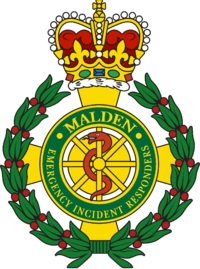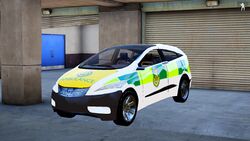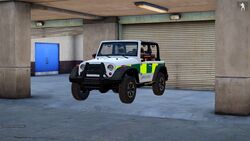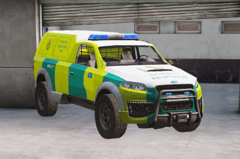NHS Road Incident Responder
| Branch Information | ||
|---|---|---|
| Average Members | 55 | |
| Current Assets | ||
| Dispatch Locations | Le Trinite | |
| Command | ||
| Chief Emergency Incident Responder |
| |
| Deputy Emergency Incident Responder |
| |
| Emergency Training Instructors |
|
|
| Quick Links | ||
| Interest Form | ||
| Timesheet Form | ||
| Member's Database | ||
| Member's Handbook | ||
| RIC Application | ||
The NHS's Road Incident Responder Branch (more commonly known as RIR) provides general safety and onsite practices for all emergency responders. Additionally, they provide maximum protection for all emergency responders operating at limited access highway incidents. They access highways with high vehicle speeds, in adverse weather conditions, helping heavy trucks, and reducing exposure to motorists with varying degrees of ability, with possible vision, alcohol, and drug impairments. All RIR members understand that the objective is to get onto the highway, perform their duties, help all the people on the island and get off the highway as quickly and efficiently as possible. This will reduce their high-risk exposure and help to get traffic patterns back to normal. RIR always operate within a protected environment at any type of incident on or near a highway.
Ranking Structure
To join RIR as a Tier 1 you must be PAR+ and complete the empty tests. You can express your interest here.
| Rank | Description of Duty |
|---|---|
| Chief Road incident Responder | The CRIR is the consultant responsible for running the entirety of the branch with support from the CMO’s. |
| Deputy Road Incident Responder | The Second highest in command.
Deputy Road Incident Responder supports the CRIR in regular decisions and helps ensure the smooth running of the branch. Also responsible for dealing with any issues caused by branch members when on Patrol. |
| Road Incident Coach | Road Incident Coaches train new recruits into the branch and support them within the branch. They conduct induction tests for Road Incident Responder wannabes.
They are the first port of call for questions regarding the branch. |
| Tier 2 | Tier 2 members have shown dedication to the branch. They have completed 25 hours of RIR patrols and are now the highest non command rank in the branch.
This grants access to a personal hatchback sport and the Offroad (Covered) Tier 2 members also get access to the HAZMAT suit and respirator for responding to hazardous or radioactive situations. |
| Tier 1 | Members that are Tier 1 RIR are fully qualified branch members who have passed all of their training.
They have access to the Hatchback Sport and the MB 4WD |
Specialist Vehicles
Road Incident Responder Garage (Branch Vehicles)
Hatchback Sport (Tier 1)
The Hatchback Sport is the modified and mechanically enhanced older sister of the standard Hatchback. With a top speed of 300km/h its extremely fast. The Hatchback Sport is vital to attending Road Traffic Collisions (RTC) where time is paramount. With great speed comes great responsibility as handling this rocket on wheels can be difficult to master. Space for 3 Passengers
MB 4WD (Tier 1)
This classic Jeep lookalike is rather agile and speedy in respect to its shape and look. The MB 4WD is utilized when attending off-road incidents where rough terrain may hinder and may also prevent other vehicles from reaching the casualties. It has a top speed of 196km/h and has a passenger capacity of 3
Offroad Covered (Tier 2)
The offroad covered is a variant of the commonly used offroad, this vehicle accessible to tier 2 members and above is useful when attending incidents on rough terrain much like the MB 4WD, however this vehicle allows for a much more efficient way of carrying passengers giving them the much needed cover from the environment as you race back to the hospital for emergency surgery.
Altis RIR Regulations
All members of the Road Incident Responder team are expected to follow these rules.
- You must never give an RIR vehicle or equipment to a non RIR medic.
- As stated above you are expected to follow the speed limits when not responding to an incident.
- RIR branch members have priority over Coastguard vehicles.
- Coast Guard boats are NOT for general patrolling - they are only to be used in an emergency at sea.
- Coast Guard boats can only be piloted by a Paramedic or higher.
- High visibility vests are meant to be used only while on RIR patrols by RIR members. If not, necessary disciplinary action will be taken. Tier 2 members can wear them on any ground patrol.
- The CBRN suit and hazmat respirator are Tier 2 perks and should therefore only be used by Tier 2 members.
- The CBRN suit is only to be used for the uranium field or if there is a roleplay cause and it has been authorised by CST+.
- The CBRN Suit is not to be used with the hi-vis vest.
Highway Laws and Regulations
As any other citizen on Altis, All Road Incident Responders must abide by the highway code and law. However, they are exempt from some laws when responding to an incident and are utilising there Blue Flashing lights and the siren is sounding.
As Road Incident Responders, you are expected to be the best group of drivers we have available within the NHS - because of this you must ensure that you are driving safely, quickly and setting a good example which may inspire others to join the Road Incident Responder branch.
Key Driving Offenses
| Dangerous Driving | Caution / £100,000 + Scrap |
| Driving without due care and attention | Caution / £15,000 |
| Driving elsewhere than on roads | £75,000 / Scrap |
| Failure to stop for the police | £10,000 upto Prison + Scrap |
Speed Limits
Inside Towns and Cities
| Dangerous Driving | Caution / £100,000 + Scrap |
| Driving without due care and attention | Caution / £15,000 |
| Driving elsewhere than on roads | £75,000 / Scrap |
| Failure to stop for the police | £10,000 upto Prison + Scrap |
Inside Towns and Cities
| Dangerous Driving | Caution / £100,000 + Scrap |
| Driving without due care and attention | Caution / £15,000 |
| Driving elsewhere than on roads | £75,000 / Scrap |
| Failure to stop for the police | £10,000 upto Prison + Scrap |
With no lights and sirens, you must follow the usual speed limits - however, whilst responding to an incident with lights and sirens, you do not have to follow a speed limit however you must stay at a controllable speed, for example do not go at 300 km/h if you can only control a Hatchback Sport at 250 km/h.
Other Information
Road Incident Responders also have access to the Yellow Hi-Vis Jacket which is worn by RIR Members when attending a scene, this is to ensure other road users can clearly see the Medics and ensure they don't become part of the incident.
RIR Members also have priority access to the NHS Coast Guard flotilla. This includes the Motor Boat (Rescue) and the Rescue Boat.



